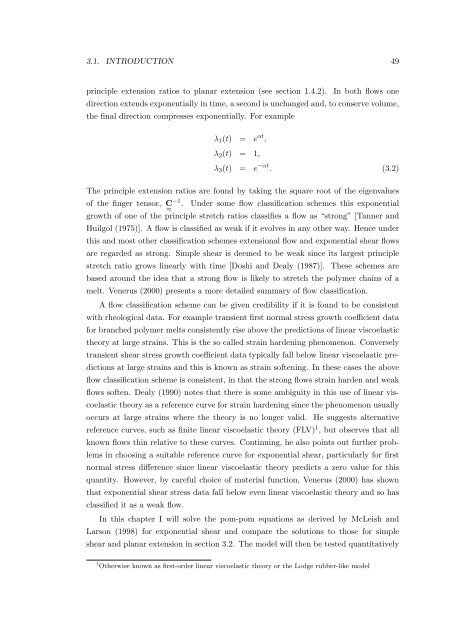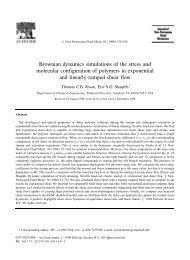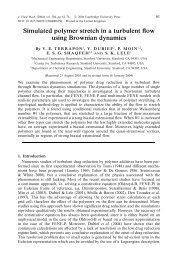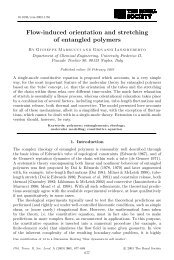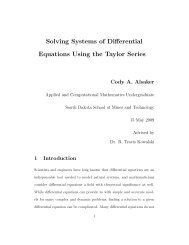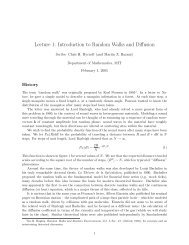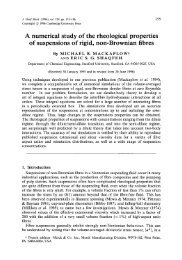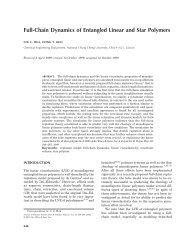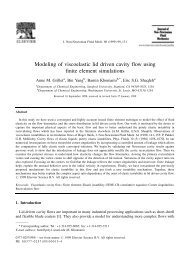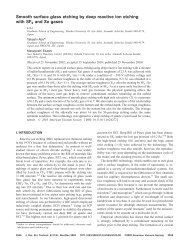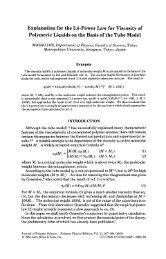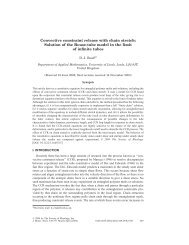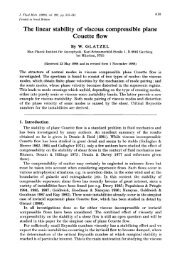Molecular modelling of entangled polymer fluids under flow The ...
Molecular modelling of entangled polymer fluids under flow The ...
Molecular modelling of entangled polymer fluids under flow The ...
Create successful ePaper yourself
Turn your PDF publications into a flip-book with our unique Google optimized e-Paper software.
3.1. INTRODUCTION 49<br />
principle extension ratios to planar extension (see section 1.4.2). In both <strong>flow</strong>s one<br />
direction extends exponentially in time, a second is unchanged and, to conserve volume,<br />
the final direction compresses exponentially. For example<br />
λ 1 (t) = e αt ,<br />
λ 2 (t) = 1,<br />
λ 3 (t) = e −αt . (3.2)<br />
<strong>The</strong> principle extension ratios are found by taking the square root <strong>of</strong> the eigenvalues<br />
<strong>of</strong> the finger tensor, C −1 . Under some <strong>flow</strong> classification schemes this exponential<br />
≈<br />
growth <strong>of</strong> one <strong>of</strong> the principle stretch ratios classifies a <strong>flow</strong> as “strong” [Tanner and<br />
Huilgol (1975)]. A <strong>flow</strong> is classified as weak if it evolves in any other way. Hence <strong>under</strong><br />
this and most other classification schemes extensional <strong>flow</strong> and exponential shear <strong>flow</strong>s<br />
are regarded as strong. Simple shear is deemed to be weak since its largest principle<br />
stretch ratio grows linearly with time [Doshi and Dealy (1987)]. <strong>The</strong>se schemes are<br />
based around the idea that a strong <strong>flow</strong> is likely to stretch the <strong>polymer</strong> chains <strong>of</strong> a<br />
melt. Venerus (2000) presents a more detailed summary <strong>of</strong> <strong>flow</strong> classification.<br />
A <strong>flow</strong> classification scheme can be given credibility if it is found to be consistent<br />
with rheological data. For example transient first normal stress growth coefficient data<br />
for branched <strong>polymer</strong> melts consistently rise above the predictions <strong>of</strong> linear viscoelastic<br />
theory at large strains. This is the so called strain hardening phenomenon. Conversely<br />
transient shear stress growth coefficient data typically fall below linear viscoelastic predictions<br />
at large strains and this is known as strain s<strong>of</strong>tening. In these cases the above<br />
<strong>flow</strong> classification scheme is consistent, in that the strong <strong>flow</strong>s strain harden and weak<br />
<strong>flow</strong>s s<strong>of</strong>ten. Dealy (1990) notes that there is some ambiguity in this use <strong>of</strong> linear viscoelastic<br />
theory as a reference curve for strain hardening since the phenomenon usually<br />
occurs at large strains where the theory is no longer valid. He suggests alternative<br />
reference curves, such as finite linear viscoelastic theory (FLV) 1 , but observes that all<br />
known <strong>flow</strong>s thin relative to these curves. Continuing, he also points out further problems<br />
in choosing a suitable reference curve for exponential shear, particularly for first<br />
normal stress difference since linear viscoelastic theory predicts a zero value for this<br />
quantity. However, by careful choice <strong>of</strong> material function, Venerus (2000) has shown<br />
that exponential shear stress data fall below even linear viscoelastic theory and so has<br />
classified it as a weak <strong>flow</strong>.<br />
In this chapter I will solve the pom-pom equations as derived by McLeish and<br />
Larson (1998) for exponential shear and compare the solutions to those for simple<br />
shear and planar extension in section 3.2. <strong>The</strong> model will then be tested quantitatively<br />
1 Otherwise known as first-order linear viscoelastic theory or the Lodge rubber-like model


